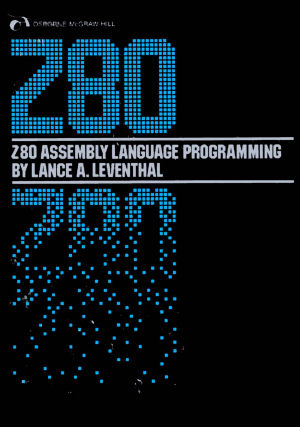ARTICLES
 |  | 41 / 74 |  |  |
![]()
![]() Z80 Assembly language programming
Z80 Assembly language programming
Auteur : Lance A. Leventhal
Editeur : Osborne / McGraw-Hill
Copyright 1979
ISBN : 0-931988-21-7
Z80 ASSEMBLY LANGUAGE PROGRAMMING provided comprehensive coverage of the Z80 microprocessor assembly language. Programming examples illustrate software development concepts and actual assembly language usage. Assemblers and assembler directives are also explained.
Features include:
- More than 80 sample programming problems
- All problem solutions in source code and object code
- Each Z80 instruction fully explained
- Complete Z80 instructions set reference table
- Z80 Assembler conventions
- Z80 I/O devices and interfacing methods
- Comparisons of Z80 and 8080A/8085 instruction sets and interrupt structure
Sommaire
Chapter 1 : Introduction to assembly language programming
Chapter 2 : Assemblers
Chapter 3 : The 280 Assembly Language Instruction Set
CPC Registers and Status Flags
Z80 Memory Addressing Modes
Frequently Used Instructions of the Z80
Abbreviations
Instructions mnemonics
Instruction Object Codes
Instruction Execution Times
Status
Instructions Descriptions
Chapter 4 : Simple programs
Chapter 5 : Simple program loops
Chapter 6 : Character-coded data
Chapter 7 : Code conversion
Chapter 8 : Arithmetic problems
Chapter 9 : Tables and lists
Chapter 10 : Subroutines
Chapter 11 : Input/Output
Chapter 12 : Interrupts
Chapter 13 : Problem definition and program design
Chapter 14 : Debugging and testing
Chapter 15 : Documentation and Redesign
Chapter 16 : Sample projects
Index of Instructions Descriptions
Index
| Article créé le : | Samedi 22 Mai 2010 à 20 h 52 |
| Dernière mise à jour le : | Samedi 03 Mars 2012 à 11 h 46 |
Programmation par Kukulcan © 2007-2025 tous droits réservés.
Reproduction sans autorisation interdite. Tous les titres utilisées appartiennent à leurs propriétaires respectifs.

